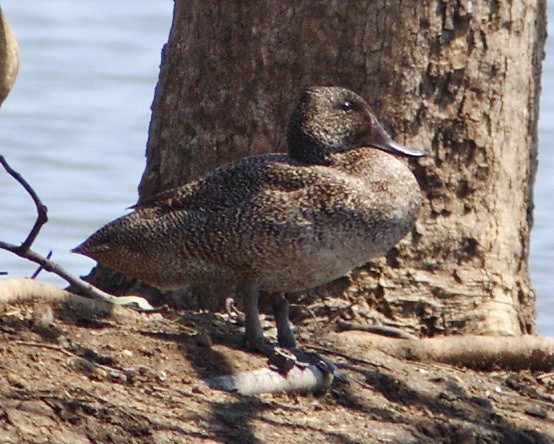Freckled Duck
A species of Freckled Duck Scientific name : Stictonetta naevosa Genus : Freckled Duck
Freckled Duck, A species of Freckled Duck
Botanical name: Stictonetta naevosa
Genus: Freckled Duck
Content
Description General Info
Description
The freckled duck has a distinctive appearance. It is characterised, in adults, by dark grey to black plumage covered with small white flecks, which gives the duck the 'freckled' look. The feet, legs and bill of both sexes is of a slate grey colour. Hatchlings and juveniles are distinguished by a uniform light grey plumage, which they lose around their 32nd week when they undergo a full body moult to assume the adult plumage. The adult freckled displays a few sexual dimorphisms, the first being size. On average, males are the larger sex, with average weight between 700 - 1200g. Females have an only slightly lower range between 600 – 1200g. Both sexes have a length of 50 – 60 cm. During the breeding season particularly, the males are characterised by the base of their culmen, which takes on various shades of red. Those in prime reproductive condition take on a deep red colouring, while other males may only develop lighter shades of red, or in some instances, no colouring at all. Deep red colouring of the culmen is also associated with dominance, and those with the deepest red are those likely to breed with the females of the group. 
Size
56 cm
Nest Placement
Ground
Feeding Habits
Freckled Duck is a specialist filter feeder found in shallow waters, sifting through mud or sand with its bill for aquatic vegetation, insects, algae, larvae, and crustaceans, displaying a versatile yet precise diet.
Habitat
Freckled Duck generally inhabit freshwater wetlands and marshes rich in emergent and fringe vegetation, favoring plant species like Muehlenbeckia, Melaleuca, and Eragrostis. These wetlands are largely situated in inland regions and are often newly flooded, crucial for breeding. Post-breeding, freckled Duck disperse to coastal areas with permanent water bodies, including lakes, reservoirs, and ponds, which may be more open and with sparse vegetation. Freckled Duck also frequent coastal lagoons and floodplains with varying salinity levels during the non-breeding season, yet they avoid marine or estuarine environments.
Dite type
Omnivorous
General Info
Feeding Habits
Bird food type
Behavior
A highly gregarious species, the freckled duck is known to have flock sizes ranging from 10-100 individuals, especially outside of breeding season. During breeding season, these flocks often break up into smaller sub-units, scattered throughout wetland and swamp systems. Despite these large flock sizes, this species is lacking in demonstrative displays towards one another, with only cryptic gestures and few interactions towards fellow flock mates. The rare interaction that is observed within this species is usually of a quarrelsome nature. 
Distribution Area
Endemic to Australia, the freckled duck is mainly situated throughout inland regions of the Eastern section of the country—including New South Wales, Victoria and Queensland. This species also has known populations in South Australia and Western Australia. Due to habitat requirements, distribution of the freckled duck directly correlates to water flow and rainfall in river catchments and wetland systems. Because of this, main populations of this species are located within the Paroo-Warrego catchment (Currawinya Lakes), Eyre-Georgine-Mulligan catchment (Lake Torquinie), and potentially at Lake Galilee. High numbers have also been recorded at the Cooper's Creek catchment, wetlands within the Barkley Tablelands, the Bulloo River catchment and Lake Gregory in central north Western Australia. Freckled duck habitat preference can be split into two distinct categories: breeding and non-breeding habitat. While this species does not appear to have any sort of distinct migratory pathway or seasonal migration to find suitable breeding habitat. The freckled duck sometimes travels long distances to find a suitable breeding location, and seems to prefer large bodies of fresh water with thick vegetation. Usual contenders are recently flooded wetland systems and swamps. After breeding, the freckled duck disperses to more coastal areas with more permanent bodies of water such as lakes, reservoirs, and ponds. These areas are often more exposed and contain little vegetation. 
Species Status
The species is currently classified as Least Concern by the IUCN. Population numbers show no definite trend, but appear to be fluctuating quite strongly, with an assessment in 2016 of 7,300 - 17,000 mature individuals. Threats include misidentification of this protected species as a game bird and consequent shooting by hunters. The ongoing destruction of swamp habitat by water diversion schemes is thought to have the capacity to result in a population decline of up to 20% within the next 15 years. 
